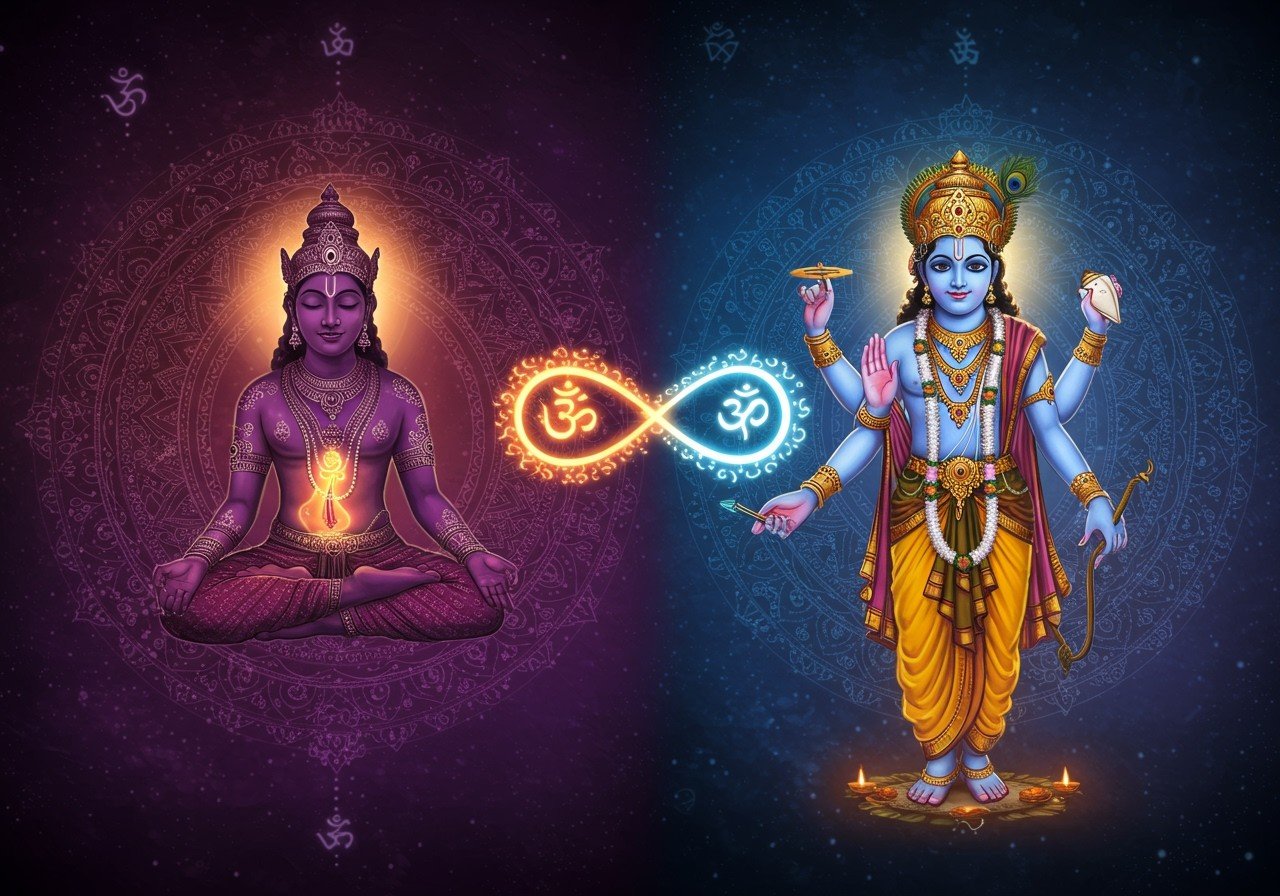Exploring the Depths of Self-Realization: Ashtavakra Gita and Bhagavad Gita

Ancient India’s spiritual legacy has gifted the world with profound texts, two of which are the Ashtavakra Gita and the Bhagavad Gita. Both scriptures delve into the journey of self-discovery and liberation, yet they approach these concepts with unique perspectives. The Ashtavakra Gita unfolds as a dialogue between the sage Ashtavakra and King Janaka within the king’s court. The Bhagavad Gita, nestled within the epic Mahabharata, portrays a conversation between Prince Arjuna and Lord Krishna amidst a battlefield.
At poojn.in, we understand the significance of these sacred texts. That’s why we offer a wide selection of spiritual products, including authentic copies of the Ashtavakra Gita and Bhagavad Gita, to support your journey of self-discovery. Visit poojn.in and explore our diverse collection. Also, check out our insightful blog posts on mindfulness meditation and the Bhagavad Gita’s impact on modern life: Mindfulness Meditation and The Bhagavad Gita’s Impact on Modern Life.
Philosophical Underpinnings
The Ashtavakra Gita champions the Advaita (non-dualistic) philosophy, asserting the unity of the individual self (Atman) with the ultimate reality (Brahman). Liberation arises from realizing this inherent oneness. In contrast, the Bhagavad Gita embraces a more comprehensive approach, accommodating various paths such as Bhakti (devotion), Karma (action), and Jnana (knowledge). This integration of diverse spiritual approaches makes the Bhagavad Gita a practical guide for navigating worldly responsibilities alongside spiritual growth. Poojn.in offers a range of products that can complement your exploration of both philosophies. Browse our Puja items for your daily spiritual practice, ensuring you have the right tools to enhance your understanding and connection with these ancient teachings.
Narrative Structures and Context
The Ashtavakra Gita unfolds as a concise and profound dialogue between sage and king, emphasizing self-inquiry and direct experience as the pathway to enlightenment. Its poetic style and focused structure make it a potent source of wisdom for those seeking immediate insight. The Bhagavad Gita, on the other hand, is interwoven with the narrative of the Mahabharata, offering guidance through Arjuna’s moral dilemmas on the battlefield. Its layered narrative and integration with the epic provide a richer context for understanding its teachings. For a deeper understanding of the Bhagavad Gita’s origin and the spiritual significance of Jyotisar, explore our blog posts: Jyotisar: The Bhagavad Gita’s Origin and Jyotisar Sarovar: A Spiritual Journey.
Core Themes and Messages
Both texts explore the nature of the self and the ultimate human goal, but with distinct emphases. The Ashtavakra Gita stresses detachment from worldly desires, advocating self-inquiry as the path to recognize the illusory nature of the ego and the world. This direct approach challenges the seeker to confront their assumptions about reality. Complement your study of the Ashtavakra Gita with our collection of sacred threads, symbolizing your commitment to the spiritual path. The Bhagavad Gita underscores the importance of dharma (duty) and righteousness, advocating selfless action as a means to spiritual harmony. It guides individuals to fulfill their responsibilities while remaining detached from the outcomes, thus achieving a balance between worldly engagement and spiritual detachment. Our range of hair oils can help you maintain a sense of calm and focus during your spiritual practices.
Comparing the Bhagavad Gita and Ashtavakra Gita
Similarities:
- Self-Realization and Liberation: Both texts ultimately aim for self-realization and liberation (moksha), offering different paths to attain this goal. They emphasize the importance of understanding one’s true nature and achieving freedom from suffering.
- Non-Identification with the Body: Both emphasize the distinction between the true self (Atman) and the physical body. They encourage recognizing the impermanent nature of the body and identifying with the eternal self.
- Detachment from Actions: Both texts encourage detachment from the fruits of actions. They advocate performing duties without attachment to the results, promoting inner peace and freedom from worldly anxieties.
Differences:
- Context and Setting: The Bhagavad Gita takes place on a battlefield, a setting of immediate action and moral dilemma, with Krishna guiding Arjuna. The Ashtavakra Gita occurs in the contemplative environment of King Janaka’s court, fostering philosophical inquiry. These contrasting settings influence the tone and focus of each text.
- Focus: The Bhagavad Gita presents a synthesis of different paths, including devotion, action, and knowledge, making it accessible to a wider audience. The Ashtavakra Gita primarily focuses on the path of knowledge (Jnana Yoga), delving deep into the nature of consciousness and self-inquiry. This specialized focus requires a certain level of spiritual maturity.
- Approach: The Bhagavad Gita integrates various schools of thought, offering a more gradual approach to liberation. The Ashtavakra Gita presents a direct and radical non-dualistic approach, challenging the seeker to immediately realize their true nature. This directness can be both liberating and demanding.
Delve deeper into the world of spiritual texts with our Bengali pocketbook edition of the Srimad Bhagavad Gita, perfect for carrying with you on your spiritual journey.
Conclusion
Both the Bhagavad Gita and Ashtavakra Gita offer profound insights into the journey of self-discovery. While the Bhagavad Gita serves as a comprehensive guide for navigating life’s complexities with spiritual wisdom, the Ashtavakra Gita presents a direct path to self-realization through the realization of one’s true nature. Each text, with its unique perspective, contributes significantly to India’s rich philosophical heritage and continues to inspire spiritual seekers worldwide.


